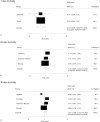Effect of high-volume hemofiltration on mortality in critically ill patients: A PRISMA-compliant systematic review and meta-analysis
- PMID: 30235713
- PMCID: PMC6160258
- DOI: 10.1097/MD.0000000000012406
Effect of high-volume hemofiltration on mortality in critically ill patients: A PRISMA-compliant systematic review and meta-analysis
Abstract
Background: High-volume hemofiltration (HVHF) is widely used for blood purification in critically ill patients with systemic inflammatory syndromes. The purpose of this study was to evaluate the effect of HVHF on mortality at different follow-up periods in critically ill patients.
Methods: We systematically searched PubMed, Embase, and the Cochrane Library through April 2017 to identify trials that evaluated the effect of HVHF on mortality in critically ill patients. Summary relative risks (RRs) and 95% confidence intervals (CIs) were employed to calculate the treatment effect using a random effects model. Eleven trials involving 1048 critically ill patients were included in this study.
Results: The summary results indicated no significant differences between HVHF and usual care for the incidence of 28-day mortality (RR: 0.93; 95%CI: 0.80-1.08; P = .321), 7-day mortality (RR: 0.72; 95%CI: 0.50-1.03; P = .072), 60-day mortality (RR: 1.00; 95%CI: 0.86-1.16; P = .997), and 90-day mortality (RR: 1.01; 95%CI: 0.88-1.16; P = .927). Subgroup analysis suggested HVHF significantly reduced the risk of 28-day mortality (RR: 0.64; 95%CI: 0.42-0.97; P = .035) if pooled the study sample size < 100.
Conclusion: Our findings suggest HVHF significantly reduced the incidence of 28-day mortality when pooled the study sample size < 100. Further, HVHF had a marginal effect on the incidence of 7-day mortality.
Conflict of interest statement
The authors have no conflicts of interest to disclose.
Figures




References
-
- Ullman AJ, Aitken LM, Rattray J, et al. Intensive care diaries to promote recovery for patients and families after critical illness: a cochrane systematic review. Int J Nurs Stud 2015;52:1243. - PubMed
-
- Cox CE, Hough CL. Improving functional recovery after critical illness. JAMA Int Med 2015;175:911–2. - PubMed
-
- Villar J, Sulemanji D, Kacmarek RM. The acute respiratory distress syndrome: incidence and mortality, has it changed? Curr Opin Crit Care 2014;20:3–9. - PubMed
Publication types
MeSH terms
LinkOut - more resources
Full Text Sources
Other Literature Sources
Miscellaneous

